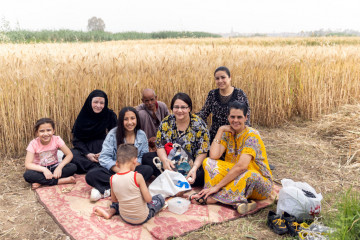

On Monday, May 6, 2024, Egyptians will celebrate Sham El-Nessim, a national holiday representing the beginning of spring and the promise of renewal.
The festival is similar to Nowruz, the Persian New Year celebrated by several ethnic groups worldwide. Like Sham El-Nessim, Nowruz is also a celebration of the first day of spring.
Celebrated every year, the festival is rooted in pharaonic traditions, and can be traced back to the ancient Egyptian celebration of “Shemu.”
This celebration symbolised the yearly flooding of the Nile River. As the waters diminished, indicating the harvest season, Egyptians would commemorate this pivotal moment with Sham El-Nessim.
Sham El-Nessim translates to ‘smelling the breeze’ in English and is originally pronounced as Tshom Ni Tshom (garden meadows).
As the translation suggests, the holiday must be celebrated outdoors, allowing the whole population to inhale the outside air.
Celebratory spaces include picnics in green spaces, public gardens, the banks of the Nile, or even the local zoo.
Before Sham El-Nessim celebrations commence, important rituals are observed usually one week beforehand. These rituals include:
Palm Sunday
The festivity commences by creating palm leaves in the form of a cross, heart, crowns, and rings. In most of Egypt, the palm leaves are interweaved with wheat, which ends up looking like a wheat basket.
The final product is the Wheat Doll, also known as the Feriek Doll. It is usually hung on house doors as a sign of a flourishing green year ahead.
Porridge Monday
Local communities will make porridge.
Bloodletting Tuesday
Local communities will eliminate the ‘bad winter blood’ by bloodletting, the practice of withdrawing blood from a person’s veins.
Ayoub’s (Job’s) Wednesday
According to folklore, Prophet Ayoub (Job) was cured by scrubbing his body with juniper, so many people follow this ritual by scrubbing and bathing in running water on Wednesdays.
Lentil Thursday
Egyptians cook lentils on this day and often eat two eggs on the side, as eggs are thought to prevent swollen eyes, which are common in the upcoming days.
Sad/Long Friday
Known as Sad by Copts and Long by Muslims, this day sees many infertile women praying for fertility in some regions.
Light Saturday
People wear Kohl eyeliner on this day to prevent eye diseases and improve vision for the coming year.
Easter Sunday
The preparations for the festival begin, and people start buying special food, and sucking on sugar cane.
Some believe placing onions under their pillow wards of ‘Al-Shamama’ (also known as "The Sniffer," a mythical figure said to sniff people while asleep).
On the day of the festival, there are a number of foods that are eaten. Referred to as the "holy five," the foods include:
Fish
Fesikh, a fermented, salted, and dried grey mullet, represents fertility and prosperity. The custom of eating Fesikh on the holiday dates back to Pharaonic days when people would present the food to their Gods, particularly in the city of Esna in Upper Egypt.
Latopolis, the city’s original name, is thought to originate from the word for tilapia fish before being salted.
For those who choose to opt out of eating Fesikh, whether due to reluctance or concerns about illness, stuffed vine leaves provide a popular alternative.
During Nowruz, celebrators also enjoy eating fish, known as mahi, symbolising prosperity and abundance akin to the tradition of consuming Fesikh.
Eggs
Eggs are eaten as Ancient Egyptians associated the holiday with the beginning of time or the world’s creation. They also believed that the whole universe appeared from a large egg.
Onions
According to Egyptian legend, the custom of eating onions stems from an incident where one of the Pharaoh’s daughters was thought to have an incurable disease. Onions were offered to help cure her condition.
When not eaten, onions are hung on the doors of homes when the holiday starts. Some believe that the vegetable wards off evil spirits and welcomes blessings to the household.
Lettuce
Valued as a sacred plant of “Min,” the God of fertility, lettuce symbolises love and abundance, as illustrated in ancient Egyptian murals.
Green chickpeas
Historically known as “malana,” green chickpeas have been used to celebrate the holiday since the era of the Old Kingdom, symbolising the start of spring and the renewal of life.
The festival would not be complete without playing popular songs such as El Rabieaa by Farid al-Atrache and Hal al-Rabie al-Gameel by Abd al-Halim.
A timeless classic also includes Tuhfet Sham Ennessim by Hassan al-Mamluk which continues to be enjoyed today.
Despite the festival's origins being linked to a Christian holiday, Sham el-Nessim is celebrated by all Egyptians, regardless of religious background or social status.
Zainab Mehdi is The New Arab's Associate Editor and researcher specialising in governance, development, and conflict in the Middle East and North Africa region
Follow her on Twitter: @zaiamehdi






 Follow the Middle East's top stories in English at The New Arab on Google News
Follow the Middle East's top stories in English at The New Arab on Google News


